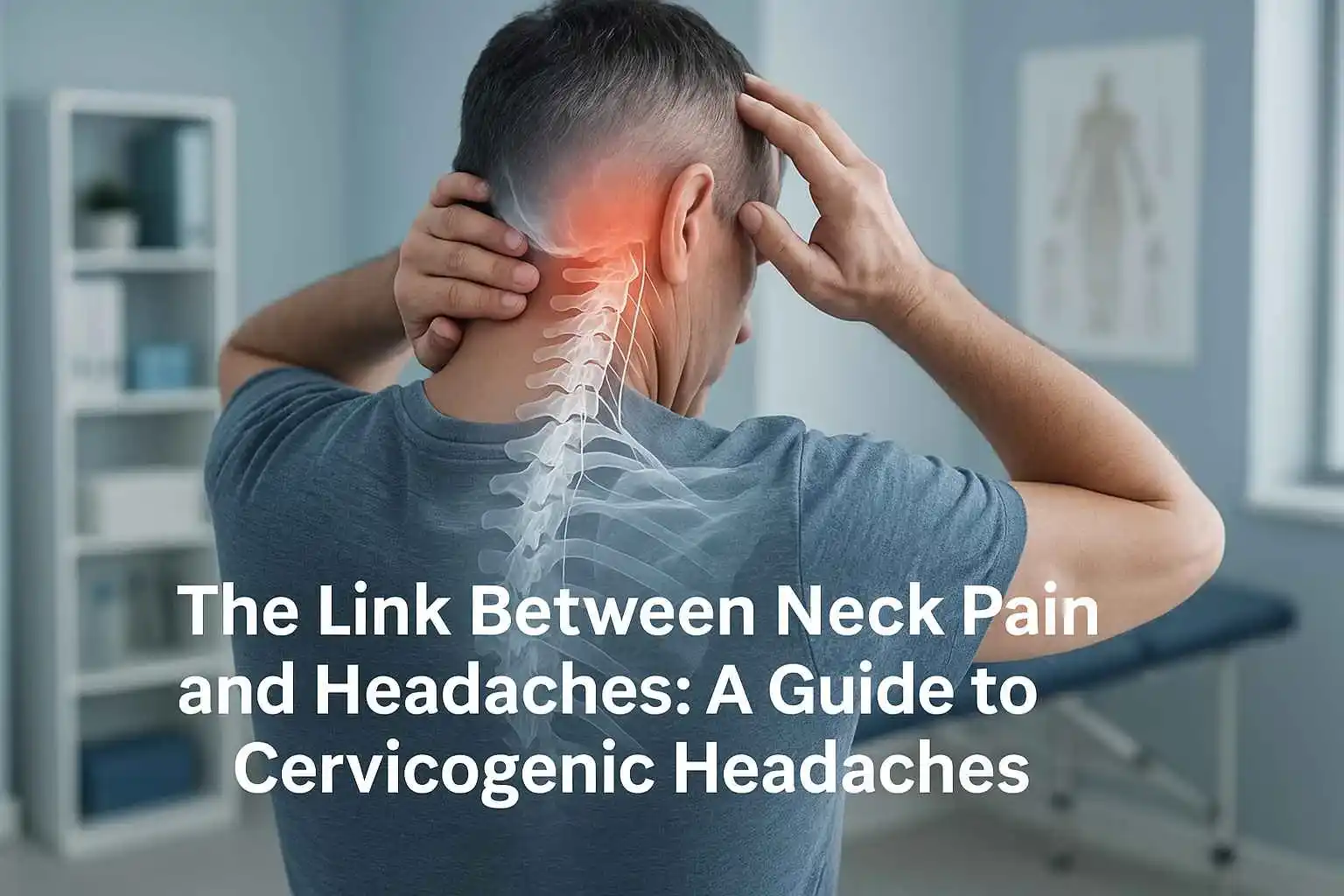That nagging, persistent headache that seems to live on one side of your head—the one that doesn't quite feel like a migraine and doesn't respond to your usual painkillers. It's a frustrating, often debilitating experience that millions of people face. But what if the source of that pain isn't in your head at all? What if it's coming from your neck?
Welcome to the world of cervicogenic headaches (CGH), a condition where pain is referred from a specific source in the neck and felt in the head.
What is a cervicogenic headache? A cervicogenic headache is a secondary headache, meaning it is a symptom caused by an underlying physical issue in your cervical spine (your neck). Pain signals from your neck travel to your brain, which interprets them as a headache.
For many in Hyderabad and across India, this condition is often misdiagnosed as a migraine or tension-type headache, leading to years of ineffective treatments and unnecessary suffering. At Germanten Hospital, we believe in empowering our patients with knowledge. This complete guide, written by our team of spine and pain management experts, will help you understand the intricate link between your neck and your head, identify the tell-tale signs of a cervicogenic headache, and explore the advanced options for neck pain treatment in Hyderabad that can finally bring you relief.
The Surprising Connection: How Your Neck Causes Headaches
It might seem strange that a problem in your neck joints or muscles can cause pain behind your eye or on your forehead. The answer lies in the complex wiring of our nervous system.
The Anatomy of a Problem: Understanding Referred Pain
Deep within your brainstem is a remarkable nerve relay station called the trigeminocervical nucleus. This is where sensory nerve fibres from the upper three cervical nerves in your neck (C1, C2, and C3) converge and communicate with the trigeminal nerve. The trigeminal nerve is responsible for feeling in your face and large parts of your head.
Because these nerve pathways are so closely connected, your brain can get its signals crossed. When a structure in your neck—be it a joint, ligament, disc, or muscle—is irritated or injured, it sends pain signals up through the cervical nerves. When these signals reach the trigeminocervical nucleus, the brain can misinterpret their origin, perceiving the pain as coming from a region supplied by the trigeminal nerve, such as your forehead, temple, or behind your eye. This phenomenon is known as referred pain, and it's the fundamental mechanism behind every cervicogenic headache.
A Modern Epidemic? Why "Tech Neck" is a Real Pain
In our modern, screen-focused world, our posture has taken a significant hit. Many of us spend hours a day with our heads tilted forward, looking at computers, smartphones, or tablets. This condition, often called "tech neck," places immense strain on the cervical spine.
Think of it this way: for every inch your head moves forward from its neutral position, it adds approximately 4.5 kilograms of extra weight for your neck muscles to support. Over time, this sustained pressure can lead to chronic muscle strain, inflammation of the neck joints, and irritation of the nerves, creating the perfect storm for developing a cervicogenic headache. This is no longer just an issue for office workers; anyone who spends significant time in a forward-head posture is at risk.
Is It a Cervicogenic Headache? Spotting the Telltale Signs
Because headaches are so common, it's easy to dismiss them. However, cervicogenic headaches have a distinct set of characteristics. If you experience the following symptoms, it's a strong indicator that your neck may be the culprit.
Key Symptoms of a Cervicogenic Headache
- One-Sided, "Side-Locked" Pain: The headache is almost always unilateral, meaning it affects only one side of your head and face. Crucially, it doesn't typically switch sides between or during attacks.
- Pain That Starts in the Neck: The pain often originates in the neck or at the base of the skull and radiates forward to the forehead, temple, or the area around the eye on the affected side.
- A Dull, Non-Throbbing Ache: Unlike the pulsating or throbbing pain of a migraine, a CGH is usually described as a steady, dull ache of mild to moderate intensity.
- Reduced Neck Movement: A stiff neck and a noticeable loss of flexibility are hallmark signs. You might find it difficult or painful to turn your head to one side.
- Pain Triggered by Neck Motion: The headache can be brought on or made worse by specific neck movements, awkward postures held for a long time (like cradling a phone), or even by external pressure on certain points of your neck.
- Associated Shoulder or Arm Pain: The pain
isn't always confined to the head and neck; it can sometimes be felt in the shoulder or arm
on the same side.
Migraine vs. Tension Headache vs. Cervicogenic Headache: A Clear Comparison
Misdiagnosis is a major hurdle for CGH sufferers. While there can be some overlap in symptoms, understanding the critical differences is the first step toward getting the right treatment. A 2022 study highlighted that neck pain is an incredibly common symptom of migraine, making it even more important to differentiate.
Here's a table to help you distinguish between the three most common types of headaches:
| Feature | Cervicogenic Headache (CGH) | Migraine Headache | Tension-Type Headache |
|---|---|---|---|
| Pain Origin | Starts in the neck/base of the skull and moves forward. | Typically starts in the head, often around the temple or forehead. | Feels like a tight band around the entire head. |
| Pain Location | Strictly one-sided (unilateral); does not switch sides. | Usually one-sided, but can switch sides or be on both. | Affects both sides of the head (bilateral). |
| Pain Sensation | Dull, steady, non-throbbing ache. | Intense, pulsating, or throbbing pain. | Dull, aching pressure; a feeling of tightness. |
| Key Triggers | Neck movements, sustained postures, pressure on the neck. | Hormonal changes, certain foods, stress, lack of sleep, bright lights. | Stress, fatigue, poor posture. |
| Associated Symptoms | Reduced neck range of motion, neck stiffness, ipsilateral shoulder/arm pain. | Nausea, vomiting, extreme sensitivity to light and sound (photophobia/phonophobia). | Mild sensitivity to light or sound, but not both; no nausea. |
| Effect of Movement | Pain is aggravated by neck movements. | Physical activity often worsens the headache. | Physical activity does not typically worsen the headache. |
What's Behind the Pain? Common Causes of Cervicogenic Headaches
A cervicogenic headache is always a symptom of an underlying problem in the neck. At Germanten Hospital, our diagnostic process focuses on identifying this root cause. The most common culprits fall into four main categories:
- Underlying Neck Conditions: Degenerative conditions are a primary cause. This includes osteoarthritis (age-related wear and tear of the neck joints), rheumatoid arthritis (an autoimmune condition affecting the joints), or issues with the intervertebral discs, such as a slipped or herniated disc that can irritate nearby nerves.
- Injuries & Trauma: A sudden injury to the neck is a very common trigger. Whiplash from a car casualty, a fall, or a sports-related injury can damage the delicate joints, ligaments, and muscles in the cervical spine, leading to chronic pain and headaches.
- Chronic Postural & Muscular Strain: As discussed, poor posture is a major contributing factor. Occupations that require holding the head in a fixed position for long periods—such as hair stylists, drivers, carpenters, and IT professionals—carry a higher risk of developing CGH due to chronic muscle tension and joint strain. Even sleeping with an unsupportive pillow can be a cause.
- Less Common Causes: In rare instances, a
cervicogenic headache can be a red flag for a more serious underlying situation, such as a
tumor, fracture, or infection in the cervical spine. This is why it is absolutely essential
to seek a professional medical evaluation for any new or persistent
headache.
The Germanten Approach: Getting an Accurate Diagnosis in Hyderabad
The single biggest challenge with cervicogenic headaches is getting the right diagnosis. Too often,
patients are told they have migraines and are prescribed medications that do little to help because
they don't address the root cause in the neck. At Germanten Hospital, we provide a comprehensive
diagnostic evaluation to ensure we identify the precise source of your pain.
Why a Correct Diagnosis is Everything
Treating a cervicogenic headache like a migraine is like trying to repair a leaky pipe by painting
over the water stain on the ceiling. It might mask the problem temporarily, but it will never solve
it. An exact diagnosis is the foundation of effective treatment. It allows us to move further just
managing symptoms and start targeting the underlying cervical problem, which is the only path to
long-term relief.
Your Consultation at Germanten: What to Expect
When you come to us for neck pain treatment in Hyderabad, our specialists will conduct a comprehensive evaluation that goes far beyond a simple description of your headache.
- A Deep Dive into Your Medical History: We'll listen carefully to your story. When did the headaches start? What does the pain feel like? What makes it better or worse? We'll ask about your daily activities, your work ergonomics, any past injuries, and your sleep habits to build a complete picture.
- A Hands-On Physical Examination: Our expert physiatrists and orthopedic specialists will perform a detailed physical assessment. This involves carefully evaluating your neck's range of motion, checking for stiffness, and gently pressing on the joints and muscles of your neck and shoulders to identify specific points of tenderness that reproduce your headache pain. We may use specific diagnostic maneuvers, like the
- Cervical Flexion-Rotation Test (FRT),
which is highly effective in identifying dysfunction in the upper neck joints linked to
CGH.
Advanced Diagnostic Tools We Use
To confirm our findings and rule out other conditions, we utilize state-of-the-art diagnostic technology.
- Advanced Imaging (MRI, CT Scan, X-ray): These imaging tests allow us to get a detailed look at the bones, discs, and soft tissues of your cervical spine. They can reveal issues like arthritis, herniated discs, or fractures. However, it's important to note that a "normal" MRI doesn't rule out a cervicogenic headache, as the problem is often related to joint function and muscle imbalance, which may not be visible on a static image.
- The Gold Standard: Diagnostic Nerve
Blocks: This is one of the most definitive tools for diagnosing CGH. The
procedure involves precisely injecting a small amount of local anesthetic near the specific
nerves or joints in the neck that we suspect are causing the pain. If the headache is
temporarily but significantly relieved after the injection, it confirms that the targeted
structure is indeed the source of the pain. This not only provides a conclusive diagnosis
but also paves the way for targeted therapeutic treatments.
Finding Relief: Your Guide to Neck Pain Treatment in Hyderabad
Once we have an accurate diagnosis, we can design a personalized treatment plan. At Germanten
Hospital, we offer a full spectrum of care, from conservative therapies to the latest minimally
invasive interventions. Our goal is to provide the most effective and least
invasive neck pain treatment in Hyderabad tailored to your specific
needs.
The Foundation: Conservative and Non-Invasive Treatments
For most patients, the journey to recovery begins with conservative care. Physical therapy is considered the first-line and most effective treatment for cervicogenic headaches.
- Expert Physical Therapy: Our highly
skilled physiotherapists do more than just give you stretches. A six-week program of
targeted manual therapy and exercise has been shown to be highly effective. Your plan at
Germanten will include:
- Manual Therapy: Hands-on techniques like joint mobilization and manipulation to restore normal movement in the cervical and thoracic spine.
- Deep Neck Flexor Strengthening: This is a critical and often-overlooked component. Weak deep neck flexor muscles force the larger, superficial muscles to overwork, leading to strain and pain. We use specialized exercises to retrain and strengthen these crucial stabilizing muscles.
- Scapular and Postural Re-education: We teach you how to strengthen the muscles that support your shoulder blades and maintain correct posture, reducing the overall load on your neck.
- Lifestyle and Ergonomic Adjustments: We
provide practical advice on setting up an ergonomic workstation, choosing a supportive
pillow, and modifying daily activities to prevent re-injury.
When You Need More: Medications and Injections
If pain is severe or doesn't respond fully to physical therapy, we can add other treatments to your plan.
- Medications: While not a long-term solution, certain medications can help manage symptoms and break the pain cycle. These may contain non-steroidal anti-inflammatory drugs (NSAIDs), muscle relaxants, or medications specifically designed for nerve pain, such as gabapentin or duloxetine.
- Therapeutic Nerve Blocks and Injections:
The same nerve blocks used for diagnosis can also be used for treatment. An injection of a
local anesthetic and a corticosteroid can provide significant pain relief by reducing
inflammation and calming irritated nerves, allowing you to engage more effectively in
physical therapy.
Advanced Interventions for Persistent Pain at Germanten Hospital
For patients with chronic, persistent pain that doesn't respond to conservative measures, Germanten Hospital offers some of the most state-of-the-art minimally invasive treatments available.
- Radiofrequency Ablation (or Neurotomy): This is a highly effective procedure for long-term pain relief. Using X-ray guidance, a special needle is placed next to the small nerve that supplies the painful joint. Radiofrequency energy is then used to induce heat, which creates a lesion on the nerve, interrupting the pain signals for an extended period—often 6 to 18 months or longer.
- Regenerative Therapies (PRP): As a leader in orthopedic innovation, we also offer regenerative treatments like Platelet-Rich Plasma (PRP) Therapy. This involves using your body's own healing factors to lower inflammation and promote tissue repair in the affected neck structures.
- Surgery as a Final Resort: Surgery is
rarely needed for cervicogenic headaches. However, if your headache is caused by a clear,
surgically correctable structural problem—like a severely herniated disc compressing a nerve
root—that has failed all other reasonable treatments, our expert spine surgeons may consider
it as an option.
A Patient's Story: Reclaiming Life from Chronic Headaches at Germanten
To understand the impact of a correct diagnosis, consider the story of Anjali, a 35-year-old IT professional from Gachibowli, Hyderabad. For three years, Anjali suffered from a relentless, one-sided headache. She was told it was a chronic migraine and tried numerous medications with little success. The pain, combined with a stiff neck, made it nearly impossible to focus at work or enjoy time with her family.
Frustrated, she came to Germanten Hospital for a second opinion. Our team listened to her story and performed a detailed physical exam, noting that specific movements of her neck instantly triggered her familiar headache. An MRI of her neck showed early signs of arthritis in her upper cervical joints. To confirm the diagnosis, we performed a diagnostic C2-C3 facet joint block. Within minutes of the injection, Anjali's headache vanished for the first time in years.
With a confirmed diagnosis of cervicogenic headache, we started her on a personalized treatment plan. She underwent a six-week intensive physical therapy program to strengthen her neck muscles and improve her posture. She also received a therapeutic radiofrequency ablation for long-lasting relief from the arthritic joint pain.
Today, Anjali is virtually headache-free. "Getting the right diagnosis at Germanten changed my life," she says. “I finally understood that my neck was the problem, not my head. The team didn't just give me pills; they gave me a solution.”
Preventing a Pain in the Neck (and Head): Your Proactive Plan
Whether you're recovering from CGH or want to prevent it, these proactive steps can make a world of difference:
- Master Your Posture: Be mindful of the "tech neck" slump. Sit up straight, with your shoulders back and your ears aligned over your shoulders.
- Create an Ergonomic Oasis: Adjust your chair, desk, and computer monitor so that your screen is at eye level and you aren't craning your neck forward or down.
- Sleep Smart: Use a supportive pillow that upholds your neck in a neutral position, whether you sleep on your back or your side. Avoid sleeping on your stomach.
- Take Movement Breaks: If you have a desk job, get up and move around every 30-60 minutes. Perform simple neck stretches (gently tilting your head side to side and forward and back).
- Manage Stress: Stress leads to muscle
tension, especially in the neck and shoulders. Techniques like yoga, meditation, and deep
breathing can help keep this tension at bay.
Why Choose Germanten for Your Neck Pain Treatment in Hyderabad?
When it comes to complex conditions like cervicogenic headaches, expertise matters. Germanten Hospital stands apart as a premier destination for spine and pain care in India.
- A True Multidisciplinary Team: Your care is managed by a collaborative team of orthopedic spine surgeons, physiatrists, pain management specialists, and expert physiotherapists, all working together to find the best solution for you.
- German Technology & Precision: We leverage world-class diagnostic and therapeutic technology, ensuring every procedure is performed with the utmost precision and safety.
- A Full Spectrum of Care: We offer everything from advanced physical therapy to the latest minimally invasive procedures and regenerative medicine, all under one roof. You won't be shuffled between different clinics; your entire journey to recovery happens here.
- A Patient-First Philosophy: We don't just
treat scans or symptoms. We treat you. We are dedicated to finding the true source of your
pain and providing a lasting solution that restores your quality of life.
Don't Let a Misdiagnosed Headache Control Your Life
If you are struggling with a persistent, one-sided headache and neck pain, don't accept it as your
new normal. The answer might be simpler than you think, and effective treatment is within
reach.
Ready to find the real cause of your headache and get lasting relief? Don't wait another day. Book your consultation with our spine and pain experts at Germanten Hospital in Hyderabad today and take the first step towards a pain-free life.




